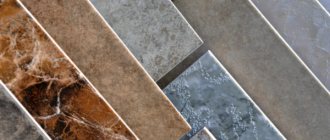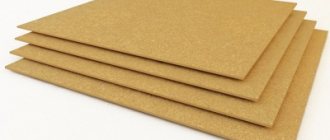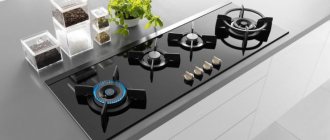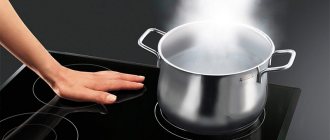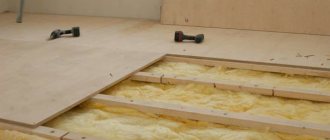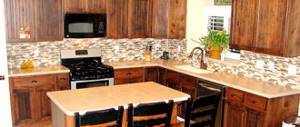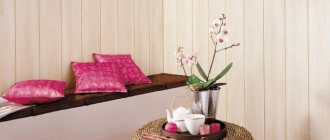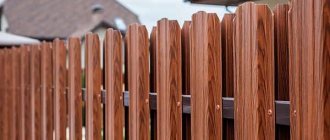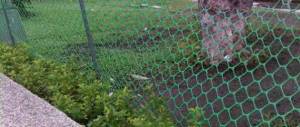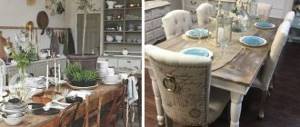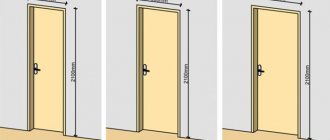Oriented strand board (OSB, OSB, OSB - short for the English expression oriented strand board) is a modern structural and finishing material that is used for various works . OSB was conceived as an inexpensive alternative to plywood and chipboard, because the ability to use non-commercial wood to make chips reduces the cost of the finished product.
Next we will tell you:
- what is OSB;
- what types of oriented strand boards are there;
- what regulatory documents regulate the quality and characteristics of OSB boards;
- what sizes do chip OSBs have, and does their price depend on this;
- how much does this material cost?
- advantages and disadvantages compared to other structural and finishing materials;
- What is OSB used for?
This is what an OSB board looks like
What is OSB?
OSB consists of several layers of thin (0.5–1.5 mm) chips of various shapes and sizes, oriented within each layer. The sizes of wood shavings for OSB are 1–20 cm in length and 1–50 mm in width. There is no clear orientation in the longitudinal or transverse direction, however, the majority of all large wood chips are oriented in the desired direction with a tolerance of up to 60 degrees (in most cases, the rotation relative to the orientation does not exceed 30 degrees).
Due to the fact that most large chips are oriented in one direction, the layer acquires increased transverse or longitudinal rigidity and strength. All layers are connected to each other using a mixture of various natural and synthetic adhesives, and each manufacturer uses its own recipe and keeps it secret. As a result, all layers combined into a single carpet jointly react to any bending or twisting force, which provides high rigidity and strength compared to chipboard.
In this case, oriented strand board is inferior to plywood in these parameters, because in plywood each layer consists of a whole sheet, so its strength and rigidity are much higher. All sheets correspond to the size accepted at the enterprise.
Types of OSB
Depending on the consumer properties, oriented strand boards are produced in several types:
- OSB 1 - for structures without loads, operation is possible only in dry rooms;
- OSB 2 - for load-bearing structures in conditions of normal humidity (for covering indoor frames);
- OSB 3 - for load-bearing structures in conditions of high humidity (external cladding for frame house construction, including as a continuous sheathing for some types of roofing materials).
- OSB 4 - for load-bearing structures with significant loads, operated in conditions of high humidity. The edge of the slab may have a recess and groove - for a connection without gaps
- Tongue and groove. The edges of the slabs are cut in the form of a tongue and groove type lock. With such an edge there can be any type of OSB (from 1 to 4). They are used if it is necessary to create a continuous flooring along a plane (for the floor, roof or walls).
- Laminated OSB. It is covered with a layer of laminate on one or both sides. Used to create reusable formwork for the construction of foundations, monolithic walls made of concrete, wood concrete, etc.
- Varnished OSB. The varnish coating on one side increases moisture resistance.
If you need moisture-resistant OSB, carefully choose the manufacturer. Be prepared for the fact that OSB 3 is more expensive than non-moisture resistant brands. You will have to pay even more money for OSB 4. We do not recommend looking for cheap material. Too many people complain that purchased OSB 3 swelled by 3-8 mm due to humidity, in some cases it even blossomed or became overgrown with fungi. All this is due to attempts to reduce costs. To do this, they use less disinfectants and a cheaper binder. Chinese manufacturers use deciduous wood instead of pine wood chips, which is easily affected by fungi and diseases.
Classification of OSB boards according to EU standards
Now even Russian manufacturers produce most OSB boards according to the standards of the European Union and the USA. We have the domestic GOST R 56309-2014. It was developed taking into account the European standard EN 300:2006 and has the same markings.
There are OSB boards EN 300 “Oriented Strand Boards of Special Specification”. The grade is distinguished by its resistance to abrasion of the front surfaces, bending strength and increased ability to retain fasteners. Dimensional strength and resistance to moisture allow EN 300 to be used in rather harsh conditions.
Example of using OSB grade EN 300
There is another European grade - EN 13986. It is classified as a slab for construction purposes. Its performance is slightly worse than that of EN 300, but the price is also slightly lower.
Properties and technical specifications
OSB boards compete with other sheet materials both in the field of construction (for covering frames, creating formwork) and in the field of finishing (leveling walls, floors, ceilings). This is facilitated by the properties of OSB:
- The strength is approximately the same as that of plywood and 2.5 times higher than that of chipboard.
- High degree of moisture resistance. According to standards, water absorption when in water during the day is no more than 10%. OSB board has become popular due to its properties
- OSB boards can be sawed and drilled with standard carpentry tools.
- Can be fastened with screws or self-tapping screws. Fasteners are held better than in coniferous plywood and chipboard.
- Not damaged by rodents and beetles.
- With normal quality, voids, delaminations and other defects are rare.
Once again, please note that moisture resistance and resistance to deformation are characteristic of OSB, which was made in compliance with the technology. Unfortunately, Russian-made material is not of high quality. Less powerful presses are used, they try to save on binders, and do not apply markings. As a result, there are many examples of negative experiences: slabs swell from moisture, they warp, the glue is washed out... The solution is to look for slabs made imported (Europe or the USA). Due to the rise of the dollar, they now have considerable prices; there are very few of them on the market, but, if desired, you can find them or order them for delivery.
Comparison of characteristics of sheet building materials
The situation is aggravated by the fact that it is impossible to distinguish moisture-resistant OSB3 from non-moisture-resistant OSB2 or 1 by appearance. The latter cost much less. Unscrupulous sellers sell cheaper ones under the guise of being moisture resistant. This is where trouble starts. As a way out, you can do this: buy one sheet of OSB 3, check its behavior at high humidity. If there are no visible changes, buy a batch.
Application area
The properties of OSB allow this material to be used as a construction or finishing material. Here are the types of work it can be used for:
- Covering frames and walls inside and out.
- Leveling the floor and ceiling.
- Laying rough or finished floors along joists.
- Removable formwork when working with concrete.
- Continuous sheathing for bitumen shingles, metal tiles, slate, soft roofing materials.
- Production of SIP panels and thermal panels.
There is constant debate among developers about how safe OSB board is. Its production uses resins that emit formaldehyde. Manufacturers claim that the release of this substance does not exceed 1%. Materials with such formaldehyde emissions are considered absolutely safe. Wood releases approximately the same amount of this substance. Therefore, such materials are allowed for the construction of children's furniture. In addition, OSB boards with emissions of 0.5% appeared. They can be distinguished by two criteria: the name contains the prefix Bio or Green and they are more expensive.
OSB board has a wide range of applications
Please note that the level of formaldehyde emission must be controlled. Each batch of material must be checked and the actual parameters indicated in the accompanying documents. Despite all the arguments, not everyone considers this material safe, preferring to use natural material - boards. They are, without a doubt, an environmentally friendly material, but the boards take longer to work with and are more expensive. In general, everyone decides for themselves whether to use OSB boards or not.
Oriented Strand Board Dimensions
Since OSB boards have different purposes, different sizes may be convenient. The situation with the sizes of OSB boards is not simple. 1220*2440 mm and 1250*2500 mm are always on sale. There are also formats 1250*2800 mm, 1250*3000 mm, 1200*6000 mm, but they are extremely rare in our market, although in many cases they are much more convenient to use. By choosing the right size, you get rid of the need to “grow” the missing centimeters or saw off the extra ones. But there are not many of them on the market, since these are imported slabs, and importing is difficult now...
OSB board can be of different thicknesses
The OSB board can be of different thicknesses - 9 mm, 12 mm, 15 mm, 18 mm, 22 mm, 25 mm. Each type of use has its own thickness:
- Wall and ceiling cladding - from 9 mm.
- Continuous sheathing for roofing materials - from 12 mm.
- An OSB board of 15 mm thickness will be used on the floor.
Another application of OSB boards is removable formwork for concrete work.
OSB board is a convenient building material. You can cut it with a regular wood saw, use a grinder with a cutting disc, or use a jigsaw. The material drills well; screw nails can be used without pre-drilling. But then their hats stick out, which is not always convenient.
Before finishing, the OSB board is coated with a primer. It is selected depending on the finishing materials - to equalize absorbency and improve adhesion to other materials.
OSB board. Characteristics. Application. OSB sheet dimensions
OSB 3 is resistant to moisture, which means short-term exposure to moisture and is extremely durable. This particular type is more necessary and suitable for exterior decoration of buildings.
OSB boards have been actively used in construction work for about several years now. And craftsmen, keeping up with technical progress, actively use OSB for wall cladding, flooring, production of removable formwork and almost all other processes. Varieties of OSB Basic dimensions Advice for buyers and prices The Americans dubbed the board with shavings arranged in perpendicular layers Oriented Strand Board.
In this case, the slabs need to be additionally impregnated and painted. OSB 4 is suitable for use in humidified environments and can withstand intense mechanical action. The technical properties of OSB 4 allow it to be used repeatedly for formwork without additional processing. There are also slabs already varnished on one side, laminated slabs that are well suited for formwork, and tongue-and-groove slabs, in which the ends are machined into a tongue-and-groove pattern, for laying over a large area.
The building materials market offers a large selection of wood products made using different technologies. One of the types is OSB boards. They are made in an improved way and are based on wood fibers laid in layers in alternating, mutually perpendicular directions.
The most popular are slabs with class 3. Thin slabs are suitable for sheathing objects that do not load the OSB sheet, frame for soft coverings, lining wood floors, walls, etc. Plates of greater thickness can be used for objects with a fairly high load on the slab, flooring, structures on which heavy objects will stand, etc. Application of OSB Thanks to the beautiful technical features of OSB, slabs are applicable in almost all areas of construction: Construction of walls of frame houses; Creation of interior partitions; Installation of flooring; Leveling the floor surface for the next installation of the finishing coating; Creation of a base for certain roofing bitumen shingles, etc.
